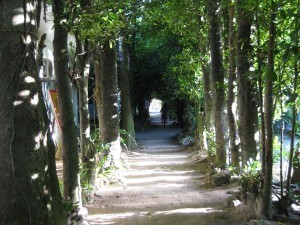Lisa Niver's Blog: We Said Go Travel, page 438
December 24, 2013
Dubai: The future of tourism
Artificial man-made islands, which when seen from space, forms the shape of the world. The tallest building ever built, topping out at over half a mile high with the world’s largest mall. The world’s tallest hotel and only self acclaimed 7 star hotel built on it’s own island. Where can you find this all these amazing attractions plus much, much more? Dubai is the answer.
Dubai has popped up almost overnight on the tourism scene, only becoming a popular destination in the past decade. Increasing the amount of Tourists has been at the front of the city’s goals, last year attracting over 9 million tourists from around the world. Dubai Holidays are increasingly becoming more and more popular year after year.
The most popular activities in Dubai include visiting the Burj Khalifa, also known as the tallest building in the world, topping out at a neck cramping 828 meters. (2,716 feet) Visiting the Burj Al Arab, the self proclaimed only 7 star hotel and last, but not least, the amazing shopping opportunities offered throughout the city.
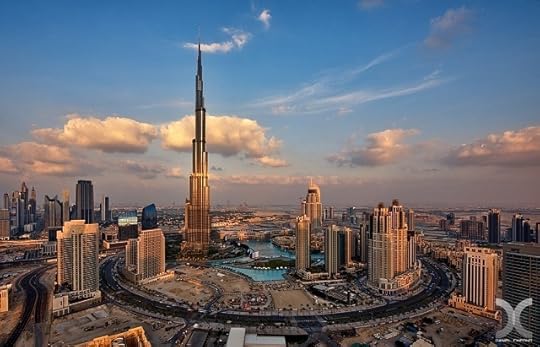
The Dubai Skyline with the Burj Khalifa. Image courtesy of Google Images
The Burj Khalifa was completed in 2010 and only took six years to build. The building has the third highest observation deck on any building which is located on the 124th floor. The indoor deck is a dizzying 1,483 feet in the sky, offering a superb view of the city below and makes people and cars look like little ants scattered across the horizon.
Another amazing building to visit while in Dubai is the Burj Al-Arab, the self proclaimed 7 star hotel. Even though no such thing exists, this hotel is about as luxurious as it gets when it comes to hotels. The lobby alone is a few feet shorter of the Eiffel Tower and wide enough that the Statue of Liberty could easily fit into it. This amazing hotel is built on it’s own man-made island approximately 900 feet from the coast and is linked to the mainland via causeway. If you’re planning on visiting, you must reserve a table, even if you’re only there to get a bite to eat. Bring money though, as the minimum plate is USD$175 per person.
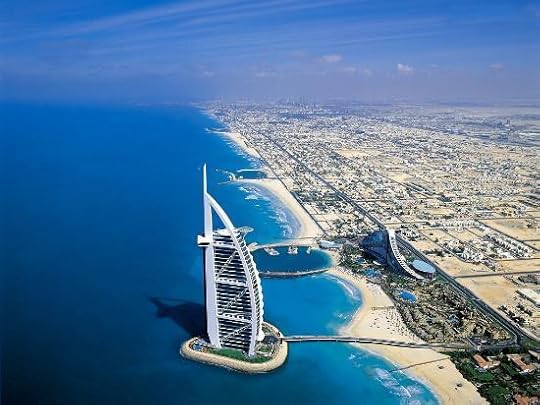
The Burj Al-Arab, the self proclaimed 7 star hotel. Image courtesy of Google Images
To boost it’s tourism, the city government of Dubai spent over USD$20 billion to renovate it’s commerce area. At the center of shopping in the city is the Dubai Mall, which has 635 retailers and attracts nearly 1,000,000 customers every single week. It is the world’s most-visited shopping destination. Surprisingly, the mall attracts more shoppers on an annual basis than tourists to New York City. The mall has an aquarium and under water zoo, an ice rink, a 22 screen theater with more than 2,800 seats and more than 1,200 shops.
Dubai is increasing tourism to the city every year. With more and more attractions to come, Dubai will continue to wow and awe visitors every chance it gets. It currently has the world’s highest building, most luxurious hotel and one of the best shopping experiences that you could ever imagine having. Visiting this truly unique city should be on the list of places to see for any tourist.
The post Dubai: The future of tourism appeared first on We Said Go Travel.
December 23, 2013
Trusting Strangers on Australian Clifftops
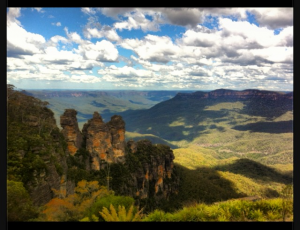 When my foot slips off the same ledge for the third time in a row, Jun groans sympathetically and tightens his grip. Swaying perilously from thirty feet above, I shoot my new rock climbing partner an apologetic shrug, await further instruction. I only met Jun an hour ago, and yet he holds my life in his hands like a marionette doll.
When my foot slips off the same ledge for the third time in a row, Jun groans sympathetically and tightens his grip. Swaying perilously from thirty feet above, I shoot my new rock climbing partner an apologetic shrug, await further instruction. I only met Jun an hour ago, and yet he holds my life in his hands like a marionette doll.
“Rotate your hips toward the wall,” shouts my Gepetto. “Don’t rely on your forearms so much. Balance all your weight on the ball of your left foot.”
I accept this advice not because of faith in my partner or an intrinsic knack for climbing technique, but because I’m out of options. My forearms are pumped to the point of no return – I can no longer trust my fingertips to support my body weight. Tentatively, my foot gropes for the exact ledge that has so recently betrayed me, and I lean into my leg. As my weight shifts onto my outer sole, my body twists and grows like ivy, giving me the extra few inches I need to reach the next hold. Jun cheers as I clamber past this problem, and once solved, I’m able to turn my back to the wall, look out at the Australian countryside, and try in vain to catch my breath.
Fat, flat-bottomed clouds rest above the Blue Mountains like cushions on a glass table, peering down lazily over the green valleys of New South Wales. Charred scars of recent bushfires litter the area surrounding the Katoomba Cascades, which now burst forth in a defiant waterfall. The crickets are nearly deafening, adding an auditory element to the total sensory overload. Even without the climb, the intensity of the view would knock me back. When added to my aching muscles, the overall effect is staggering.
And so I sat, struck. As sweat evaporated from the backs of my hands, my body cooled and my mind calmed. My grateful grin met Jun’s beam of pride, and I wordlessly thanked my puppeteer.
I could have visited the Blue Mountains alone. Their enormity and beauty were unchanged by my and my friend’s presence, and yet the experience was all the more striking with company. I could have taken a bus to a lookout point, and seen the landscape. The blue haze would linger whether I climbed for it or not, and yet it seemed brighter somehow, as if I had physically earned the view.
I travel because each new vista, each sunset, each horizon enhances the others. I climb mountains to earn these horizons, to make them that much sweeter after the salty taste of sweat. But most importantly, as Jun taught me, I embrace my need for help in order to create something more than I could discover alone. As a solo traveler, independence is a pet point of pride, but experiences are deepened and enhanced when shared. Jun and I may go on to become lifelong confidantes. We may never speak again. Either way, allowing ourselves to trust each other quite literally let us reach new heights. For this connection, even more than for the awe-inspiring scenery – for this I am grateful.
About the Author: Brooke Watson is a former athlete, future doctor, and present gypsy. Sometimes she takes pictures.
.
The post Trusting Strangers on Australian Clifftops appeared first on We Said Go Travel.
Grand Canyon, USA: A place for you and me
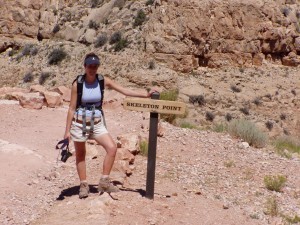 In the moment, I didn’t realized the impact beating twenty mules to the top of the Grand Canyon would have on my life, nor when I played for hours in a remote lake in Canada with sun fish swimming all around me as a kid, or the first time I saw a midget rattle snake in the wild. Over the past thirty years parks and wild places have shaped me in ways beyond my imagination. I’ve based my life around parks and travel the world seeking to explore them. I’ve built trails in the mountains of Colorado, been a park ranger in the forests of Vermont, dove with sharks in the Great Barrier Reef and hiked hundreds of kilometers along New Zealand’s Great Walks. In my job, I maintain and foster a safe and positive environment for hundreds of people to recreate in. In my personal life, I am always planning my next adventure to a new place. Parks are important and they matter. There is a life force that comes from these special and protected places that binds us all, whether we are aware of it or not.
In the moment, I didn’t realized the impact beating twenty mules to the top of the Grand Canyon would have on my life, nor when I played for hours in a remote lake in Canada with sun fish swimming all around me as a kid, or the first time I saw a midget rattle snake in the wild. Over the past thirty years parks and wild places have shaped me in ways beyond my imagination. I’ve based my life around parks and travel the world seeking to explore them. I’ve built trails in the mountains of Colorado, been a park ranger in the forests of Vermont, dove with sharks in the Great Barrier Reef and hiked hundreds of kilometers along New Zealand’s Great Walks. In my job, I maintain and foster a safe and positive environment for hundreds of people to recreate in. In my personal life, I am always planning my next adventure to a new place. Parks are important and they matter. There is a life force that comes from these special and protected places that binds us all, whether we are aware of it or not.
One of my most impactful adventures was when my husband and I geared up for an overnight backpacking trip down to the bottom of the Grand Canyon. We lived for six months in Flagstaff, Arizona and made dozens of trips to the Grand Canyon. Permit affixed to my faded purple backpack, our boots crunched against the coarse stones as we descended Skeleton Pass. About forty minutes into the hike, we had passed the hordes of people wearing white tennis shoes and carrying a single plastic water bottle. Vultures flew overhead giving a brief reminder of how precious shade was in this barren world. Out West in the summer there was almost a daily guarantee of thunderstorms. Although we started our trek early, we were chasing time to try and get to the bottom and set up our shelter. With thick, growing masses of black clouds we increased our pace and propelled ourselves towards the sound of the roaring Colorado River.
Lightly bouncing, we crossed a black suspension bridge arching about 420 feet in length over the chocolate brown water as we quickly hiked to find our camp spot. The rain drops started to splash upon us as we zipped ourselves into the tent. Sitting inside we played cards for an hour as thunder and heavy rain pounded our tent. We emerged to sunshine glistening off a freshly washed red canyon floor. Desert flowers twinkled in the sun as we explored the bottom of the Grand Canyon.
After an early breakfast of oatmeal and tea, we packed up camp to ascend Bright Angel trail. We paused for a water break and heard the clanking of metal shoes and creaking of leather as a guided pack of twenty mules approached us. Being stuck behind this line of slow moving, pooping mules was not our idea of what climbing out of the Grand Canyon would be like. If they got in front of us on this narrow trail alongside the 1000 foot cliff we would not be able to pass them. Quickly buckling our packs, we took off propelling ourselves out of the canyon. Gazing out from the top of the rim we never spotted that mule pack again and reflected how we had been ‘down there’ and spent a precious night of our lives at the bottom of the Grand Canyon.
Our time in the Grand Canyon was one of hundreds of amazing experiences we have had in a park on this planet. Parks are for the people and it doesn’t matter if a person is from America, the UK, Africa or any other country in this world, we can all go to the Grand Canyon and have our own unique experience, yet also relate with the fondest of memories a place can bring when we share our stories with each other. Parks are for everyone to explore, connecting us and grounding us in the reminder that we are all human and have the same basic needs no matter what class we are or where we were born.
We all need special places we can lose ourselves for a little bit. The ability for any one element to thread us so deeply as human beings constantly creates a sense of awe in me. For each humbling lesson a park somewhere in this world has shown me, I am truly grateful and I find the stewardship of these places worth dedicating my life to. If you find yourself feeling disconnected and looking for a reminder of something greater than yourself, get to a park today. These parks are there for you and for me; the joy is when we discover their greatness collectively.
About the Author: Tiffany Soukup: After her first year at university, Tiffany moved to Wyoming in the spur of the moment decision and she has never looked back -embracing a life of travel, exploration and endless curiosity. She and her husband Chris share the same dream of living on all seven continents. Follow their story as they venture from sorting potato’s, picking cherries, living as Inn Keepers, hiking into remote jungles and planning their next adventure.
The post Grand Canyon, USA: A place for you and me appeared first on We Said Go Travel.
HuffPost: Do You Love Your Money?
 While reading Money: A Love Story by Kate Northrup, I really thought about my relationship to my finances. I did not think my money needed love or attention but she says it is time to take “responsibility for our money, our stories and our lives.” Although I have always felt in charge of my working life, I have ignored my IRAs and retirement accounts.
While reading Money: A Love Story by Kate Northrup, I really thought about my relationship to my finances. I did not think my money needed love or attention but she says it is time to take “responsibility for our money, our stories and our lives.” Although I have always felt in charge of my working life, I have ignored my IRAs and retirement accounts.
When I was home recently after being away for over a year, I did open all the mail from various banks and institutions and put it in a pile, but did not actually read any of it. A month later, I received a letter that due to non-response, one of my accounts had been moved. I realized it was time to act. I counted up and realized I had eight separate retirement accounts at five different locations. As Northrup would say, I needed a date with my money.
After each job move and sabbatical, I considered consolidating the accounts, but it seemed challenging or was not my priority. However, when I wanted enough money to travel, I was able to create an additional income stream and save in order to get what I wanted. I agree with Northrup that when we say: “‘I can’t afford that,’ it’s not about the money. If you really wanted it, you would figure out a way to get it. If it were that VALUABLE to you, you would make it happen.” So, I decided having my accounts in one place was important and I spent the better part of three days making calls, filling out forms and getting organized.
I nearly felt that I would need to go back to school and join my friend, Nancy, at her new business management courses in order to manage it all. But every single time I got frustrated, I simply picked up the phone and asked for help. As I worked through all the accounts, it became fun as I realized I had over three times the amount I had originally figured. Northrup says, “If you can’t see your value, the world doesn’t give value back.” The more attention I paid to my money, the more I was discovering! I even found $200 in cash in my own wallet!
 I realized I did not need to go back to school, I simply needed to focus. In Forgiveness: 21 Days to Forgive Everyone for Everything by Iyala Vanzant, she says that: “Life follows the energy of our focus and faith.” I chose to put my energy into getting organized and suddenly it was simple, fun and I had all the help I needed.
I realized I did not need to go back to school, I simply needed to focus. In Forgiveness: 21 Days to Forgive Everyone for Everything by Iyala Vanzant, she says that: “Life follows the energy of our focus and faith.” I chose to put my energy into getting organized and suddenly it was simple, fun and I had all the help I needed.
Vanzant continues: “It is always so much easier to blame someone else rather than accepting responsibility for your experiences. Whether it is a breakdown in a relationship or a lack of financial substance or a failure to fulfill a dream or goal, there must be ‘someone’ to blame.”
At first when I tried to get my money organized, I complained that it was too complicated or I did not have time. I blamed the companies for not helping me enough. I realized that I did not need to blame anyone, I just asked for help and did the task one step at a time.
The process is ongoing as there will be more hoops to jump through before all my money arrives at my favorite institution, Ameritrade. I am content that my recent date with my money went so well and plan to organize more moments in the future to focus on what is valuable to me.
This article first appeared in the Huffington Post. Please share below how you are taking care of your MONEY!
About the Author: Lisa Niver Rajna is a passionate writer, speaker and global citizen who has traveled to over one hundred countries and six continents. She and her husband, George, co-authors of Traveling in Sin, have been on the road since July 2012, follow their journey at We Said Go Travel.
The post HuffPost: Do You Love Your Money? appeared first on We Said Go Travel.
Yubeng Villages, Meili XueShan OR How to Avoid Spending a National Holiday with a Billion Chinese
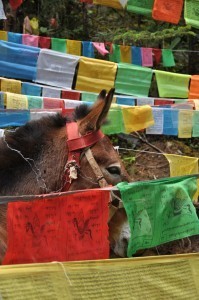 In the absence of a proper access road to upper and lower Yubeng villages, a capturing charm resonates in the valleys where they reside. At the foot of the year round snowcapped Meili mountains, a forested valley houses several traditional Tibetan dwellings. These days almost every house functions as a humble, though character full, guest house. Roads? Null. Only paths, muddy ones, with donkey convoys and hundreds of pigs. In the villages – the shower is solar (i.e. incidental). Heating? by wooden stoves only. And only fresh water, flows from the snowed peaks in pipes and channels straight to the houses. All the food supply is carried to the villages with the help of donkeys struggling up the range that separates modern Chinese civilization and the peaceful serenity that can be found in this place.
In the absence of a proper access road to upper and lower Yubeng villages, a capturing charm resonates in the valleys where they reside. At the foot of the year round snowcapped Meili mountains, a forested valley houses several traditional Tibetan dwellings. These days almost every house functions as a humble, though character full, guest house. Roads? Null. Only paths, muddy ones, with donkey convoys and hundreds of pigs. In the villages – the shower is solar (i.e. incidental). Heating? by wooden stoves only. And only fresh water, flows from the snowed peaks in pipes and channels straight to the houses. All the food supply is carried to the villages with the help of donkeys struggling up the range that separates modern Chinese civilization and the peaceful serenity that can be found in this place.
So what did we do here 8 days?
It all started with the warnings about the national Chinese holiday which takes place on the 1st of October and lasts a week. “You will not be able to find any vacant rooms, neither bus tickets”, we were told, and “The prices will soar by 300% and more”. We were prepared for the worst: a billion Chinese who decide that their destination for this year’s national holiday is the north Yunnan district. That is why we decided to slide under the radar; We heard about the Yubeng villages many weeks ago and decided to head for the mountains for a period of time.
Getting to the villages is a long and exhausting day’s climb, which takes you to a mountain pass, decorated with prayer flags, and later winds down steep paths to the villages. We stopped to catch our breath for a moment during the ascent and then a young tall and handsome guy, not Chinese looking, with a mischievous look, going the other direction, stopped by us and said: ” Are you on your way to upper Yubeng? I have a hostel there. You can stay with me… I saw 6 other Caucasians on the way to our village and they will stay with us as well”. Except for the CSI description he had for tourists, he seemed nice and his merry manner convinced us to search for his sister Monica in upper Yubeng.
There are several fun day hikes around the villages; one climbs to a frozen lake, a second ascends to a sacred waterfall – through a gorgeous forest and all in typical Tibetan quiescent. Prayer wheels and prayer flags and a holy mountain that has fountain water so holy, that Tibetan pilgrims fill bottles with its water to take back to their families who live hundreds of kilometers away. On the day we set foot atop the holy waterfall basin the sky was clear and the sun was shining. We saw several locals and tourists shed their clothing and circle the freezing waterfall. They must know what they are doing, we thought, and joined them.
After two sunny days, clouds swaddled the valley and a constant, annoying drizzle began. It rained for three days straight! On the fourth day we decided we want to take a chance, so we headed out to a steep 3.5 hours of climbing up over 1000 (vertical) meters, through very dense forest vegetation. At the end of the ascent we were awarded with a good leg stretch while the clouds began to fade. We climbed a further 400 (vertical) meters to God’s lake, an alpine lake with fresh-holy water. A beautiful rainbow shined bright over the Yubeng villages below us in the valley.
On the last day we had a hard time saying goodbye.
We left with a heavy heart. Not like leaving a beautiful place that you hope to see again one day, someday in the future. But like leaving a place that you know will not look the same the next time you will see it. This we heard: the Chinese are planning to provide accessibility for all tourists to this small piece of heaven. In the near future it is possible that the 5 hours climb over the mountain pass will not be needed and a road or cable way will help visitors easily arrive to the villages.
We hope you will succeed to see Yubeng and the Meili mountains on time, before this happens.
About the Authors- Oran and Lihi: We are an enthusiastic Israeli couple bitten by the travel bug. After previous individual travels to many countries, we set out together last spring to a yearlong adventure in Asia. Please visit our travel blog at: www.lihiandoran.com for many more stories, pictures and helpful info for visiting China, Mongolia, Myanmar, Sri Lanka and Nepal. Thank you!
The post Yubeng Villages, Meili XueShan OR How to Avoid Spending a National Holiday with a Billion Chinese appeared first on We Said Go Travel.
December 22, 2013
Hawaii USA: Finishing the Ironman Triathalon
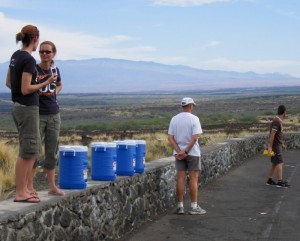 Further, harder, longer times three.
Further, harder, longer times three.
There I was out in the moonscape that is the lava fields on the leeward side of the big island of Hawaii. The hot wind was pushing my bicycle slightly sideways and my knuckles were turning white having to grip the handlebars. Riding out of the saddle meant a vertigo sensation of rocking against slightly changing, unpredictable air currents. Sweat drips out of my helmet as my body tries to cope with the furnace like heat not only beating down but radiating up from the black road surface. If I aren’t careful keeping this lightweight piece of carbon-fiber and metal alloy in a straight line the few scraggly trees hat have thrown down two inch thorns almost invisible on the road are just waiting to puncture slim racing tires. That’s if the sharp granules of volcanic grit don’t burst the rubber first.
What am I doing here? Taking a last ride before I toe the start line of the World Ironman Triathlon Championships, an event documented as the longest one day endurance race on the planet.
Consisting of a 3.8km swim, followed by 180km bike and a full marathon, the clock started at 7am and all three disciplines needed completion before midnight in order to earn the non gender specific title of IRONMAN! Everything was made harder by Open Ocean swimming (currents and swell), sometimes escorted by spinner dolphins, and then cycling on roadways that intersected the lonely, empty vistas where one is likely to see the local donkeys before encountering another competitor. On my first bike ride out from Kona I set out to find the hill someone told me inclined for 25 miles, with a mindset that such a climb simply was not possible. I was overawed by one of the first lookouts. Cresting a small rise I’d passed a sign that declared “donkey crossing” and a breathtaking wide open panorama greeted. Spinifex grasses the only vegetation clinging to crevasses in the black molten looking rocks. My forthcoming competitive bike ride was to be 180km (6 or 7 hours) in this, I could not even imagine further than the point at which I stopped. Not to mention the trade winds that knife across the island strong enough to blow cyclists off their bikes. After withdrawal of bike from one’s posterior on race day, you need to endure convincing your legs to run out into the heat and humidity even back out onto the Queen K highway towards the ‘energy lab’ where all physical energy seems to be sucked out reducing runners to a slow-snail-shuffle.
On this trip the Goddess Pele has made her disgruntlement felt already. Preparing for a lead in event, 10km fun run along the famed A’Ali drive the earth shook with a 6.7 Richter scale earth quake. Lava rock fences had tumbled down, Honolulu airport had been closed; tourists in Waikiki had fled into the streets and the epicenter was only up the road at the bike-turn-around point the sleepy village of Hawi. Still the run went ahead with the local organizers saying ‘that was nothing,… just a little cough’! But faced with Ironman distance triathlons the fear factor is difficult to evoke.
This little earth-trembling hiccup played havoc with our arrangements for the last training ride. We can no longer ascend the major hill up to Hawi because the highway is closed. So our troop of Aussies is dropped at the base and will cycle back to town – a distance of 45kms. Our support crew points out a landmark known as “Bum crack Hill” we can all see the resemblance but much discussion is about if locals also use this term or is that name only coined by irreverent Aussies? So our support crew waits at the half-way point of this road with cold drinks as equally dwarfed by the landscape as we feel. And they wait, wait, peer down the long empty roads and wait some more.
About the Author. Karen grew up in Perth, West Australia. She has travelled widely, often as a member of Triathlon teams, sometimes representing her country. Twice being able to complete the epic World Ironman Triathlon Championships in Hawaii. Professionally she teaches English and her fiction writing work can be found on various websites or in magazines.
The post Hawaii USA: Finishing the Ironman Triathalon appeared first on We Said Go Travel.
Liverpool, UK: The Royal Liver Building
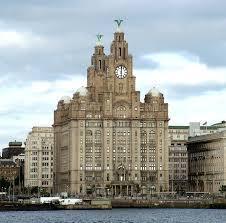 When people think of Liverpool, they probably think of football, the Beatles and the iconic emblem that represents some of the city’s most enduring mythology, the Liver birds! Visitors to the city are likely to spot the instantly recognisable birds almost immediately if they enter via one of the two tunnels that cross from the Wirral Peninsula, as they would soon drive within sight of the building that is home or ‘roost’ to the birds: the Liver Building.
When people think of Liverpool, they probably think of football, the Beatles and the iconic emblem that represents some of the city’s most enduring mythology, the Liver birds! Visitors to the city are likely to spot the instantly recognisable birds almost immediately if they enter via one of the two tunnels that cross from the Wirral Peninsula, as they would soon drive within sight of the building that is home or ‘roost’ to the birds: the Liver Building.
One of the ‘Three Graces’, along with the Cunard Building and the Port of Liverpool Building, that make up the most recognisable part of Liverpool’s UNESCO World Heritage site waterfront, the Grade I listed Liver Building was erected in 1911 and has always been home to the Royal Liver Assurance company. The famous birds are said to have been modelled on the cormorant, although they have been highly stylised, and they are positioned so that one sits looking towards the River Mersey while the other faces inward, watching over the city. Local mythology states that Liverpool will fall if the birds should ever fly away.
The imposing, thirteen-storey building was constructed using reinforced concrete, an innovation at the time of its construction, and at 300 feet was the tallest building of its kind in Europe until the 1930s and remained the tallest building in the UK until 1961. However, it is no longer even the tallest building on Liverpool’s waterfront. The enormous clocks on one of the Liver Building’s towers are larger than Big Ben and are scrupulously maintained, allowing passing ships – or ferries – as well as those inland to keep track of the time. As the clocks were started at the moment that King George V was crowned, they were once known as ‘George’ clocks and the electronic chimes now associated with them were added later as a tribute to Royal Liver workers who had been casualties of the World Wars.
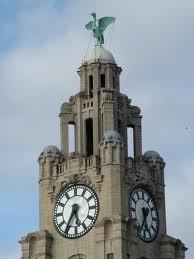 Although it’s not possible to tour the building as it is still a working environment with several floors of offices, it’s something of a ‘must-see’ destination for tourists, who can combine a trip to the Pier Head with some leisurely bargain-hunting in the nearby Liverpool One shopping centre. The area directly in front of the buildings is a good site for a picnic or somewhere just to sit and enjoy a coffee from a local shop, as it is beautifully maintained and has plenty of benches from which to survey the impressive architecture, a number of pieces of public sculpture and the vision of the river and the picturesque shoreline opposite. Arguably, the best view of the Three Graces is to be seen from the river itself, which can be managed by hopping on board one of the Mersey Ferries. For the price of the trip to the Wirral and back, you get a potted lecture on the history of the ferries and a trip down memory lane as the strains of Gerry Marsden’s ‘Ferry Cross the Mersey’ helps passengers to alight.
Although it’s not possible to tour the building as it is still a working environment with several floors of offices, it’s something of a ‘must-see’ destination for tourists, who can combine a trip to the Pier Head with some leisurely bargain-hunting in the nearby Liverpool One shopping centre. The area directly in front of the buildings is a good site for a picnic or somewhere just to sit and enjoy a coffee from a local shop, as it is beautifully maintained and has plenty of benches from which to survey the impressive architecture, a number of pieces of public sculpture and the vision of the river and the picturesque shoreline opposite. Arguably, the best view of the Three Graces is to be seen from the river itself, which can be managed by hopping on board one of the Mersey Ferries. For the price of the trip to the Wirral and back, you get a potted lecture on the history of the ferries and a trip down memory lane as the strains of Gerry Marsden’s ‘Ferry Cross the Mersey’ helps passengers to alight.
Although the Three Graces, Liverpool One and many other attractions, such as the Albert Dock, Tate Liverpool and the Museum of Liverpool are all relatively close to one another, surrounding The Strand, with plenty of safe, affordable parking in the area, it’s definitely better to drive. Many great tourist destinations are further afield, including both football grounds, sites of interest to Beatles Fans, such as Penny Lane or the Beatles’ childhood homes and several beautiful Victorian parks. With car hire in Liverpool opens up as a fantastic place to spend a day, a weekend or longer.
About the Author: Tim Banks loves travelling around the Europe. He works in a full time accountant role and knows how to take time out (of his annual holidays) to really explore the highlands and much more of what Europe has to offer.
The post Liverpool, UK: The Royal Liver Building appeared first on We Said Go Travel.
The Vacation Gals: Palau: Royal Treatment Under and Above Water
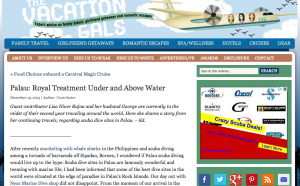 Thank you to the Vacation Gals for publishing my story: Palau: Royal Treatment Under and Above Water
Thank you to the Vacation Gals for publishing my story: Palau: Royal Treatment Under and Above WaterAfter recently snorkeling with whale sharks in the Philippines and scuba diving among a tornado of barracuda off Sipadan, Borneo, I wondered if Palau scuba diving would live up to the hype. Scuba dive sites in Palau are famously wonderful and teeming with marine life; I had been informed that some of the best dive sites in the world were situated at the edge of paradise in Palau’s Rock Islands. Our day out withNeco Marine Dive shop did not disappoint. From the moment of our arrival in the shop, the entire dive team — especially Dive Instructor Dale — went above and beyond the call of duty.
WATCH: Diving Palau by Terry Gardner
Whether snorkeling or diving, each person was given attention to make sure they were prepared for an excellent day of adventure. We were all primed with our green Rock Islands cards that are required for entering the water in this UNESCO protected area.
Our first scuba dive site in Palau was Coral Garden. In Coral Garden, I immediately felt like I was in a magical place. During our hour underwater reaching depths of 47 feet, my dive buddy, Terry, and I saw green turtles, anemones, clams, purple and green damselfish, angelfish as well as mackerel. We slowly meandered through the reef garden, enjoying every second of our Nitrox dive.
Read the full article on The Vacation Gals! Click Here.
Enjoy all our Videos from Palau: Click here!
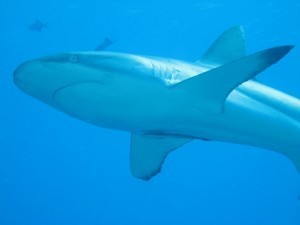
Photo by Dale Goosen and Jenni Wilbourn, Neco Marine Dive Shop
Palau Visitor’s Authority Thank you to the for inviting us to explore the magic of Palau!
The post The Vacation Gals: Palau: Royal Treatment Under and Above Water appeared first on We Said Go Travel.
Australia: Travelling on the Indian Pacific
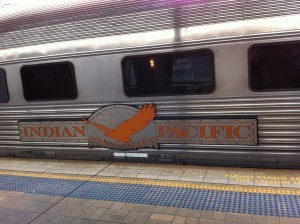 “I don’t think I could eat our national emblem,” Lisa comments as I lift my fork to my mouth. I pause, think for a while and then pop my piece of kangaroo steak in. It has a delicious smokiness to it. As I chew I think briefly of the unfortunate kangaroo the train hit during the night. Earlier that day, while rattling across the endlessly flat landscape, there’d been an announcement explaining the huge thump which had woken me, and conveying the somewhat disturbing information that our brakes have been damaged. Hopefully that’s not as bad as it sounds.
“I don’t think I could eat our national emblem,” Lisa comments as I lift my fork to my mouth. I pause, think for a while and then pop my piece of kangaroo steak in. It has a delicious smokiness to it. As I chew I think briefly of the unfortunate kangaroo the train hit during the night. Earlier that day, while rattling across the endlessly flat landscape, there’d been an announcement explaining the huge thump which had woken me, and conveying the somewhat disturbing information that our brakes have been damaged. Hopefully that’s not as bad as it sounds.
It’s the second day in our journey from Sydney to Perth in the sleek silver lines of the Indian Pacific; a journey which will take us three days and nights across this vast continent. As we speed along and the solitude of the Australian landscape is reinforced kilometre by kilometre, the sense of adventure heightens. OK this isn’t breaking new ground, roughing it or high thrills adventure, but nonetheless being on this train emits a whiff of Hercule Poirot and an echo of a bygone way of travel. “Won’t it be boring?” ask friends. Quite the contrary.
After leaving the greenness of Sydney and the Blue Mountains we enter the typical Australian bush of gum trees and barrenness seeming to stretch forever. The lush green of Adelaide follows and then the redness of the Nullarbor Plain. We go to sleep one night and wake up the next morning to an outlook which is completely unchanged. The extent and barrenness of the Nullarbor (which in Latin means no trees) is awe inspiring.
Throughout the journey we see lots of kangaroos hopping along. A line of 12 camels ambling across the Nullarbor disrupts breakfast one morning and dingos stand and watch as the train rolls by. A group of emus look flustered and harassed as they rush past. Sitting, looking out the window, far from being monotonous, has a hypnotic effect and you never know what you might see.
Stops along the way are a fascinating glimpse into the variety of Australian ways of life. Broken Hill is Australia’s oldest mining town and still dominated by the mining industry. We have half a day in nervous little Adelaide, trying to assert itself against its grander sisters Sydney and Melbourne and admire its Victorian buildings and Englishness. Tiny Cook in the heart of the Nullarbor, (population 4) has a feeling of total isolation and a temperature of 30 degrees when we are there at 9.00am. We arrive in Kalgoorlie in the evening, forego the tour and wander around this beautiful old gold town with its wide, tree lined streets and impressive Victorian buildings. We select one of the many two-storied verandahed hotels for a drink and sit watching the world go by before heading back to the train.
Life on the train is a little world unto itself and we soon settle into its rituals. A wake up morning cup of tea starts the day, then a shower. Breakfast is a rolling meal, but lunch and dinner are booked. It’s nice to have a drink beforehand and there’s plenty of time to enjoy it.
We enjoy meeting our fellow passengers as much as seeing the country. Most in our area of the train are older Australians and it’s refreshing to see people out enjoying their own, very spectacular, backyard. Our dining guests change daily and they are as varied as the landscape. Mark and Brenda are retired academics from Perth. Mark has a botched knee operation so is confined to a wheelchair much to the disappointment of Brenda who has been looking forward to a retirement of travel. She, Mark and their two children have a ‘country competition’ and she is falling behind the goal of visiting as many as her age.
Lisa and Brendan from South Australia are a complete contrast. Very garrulous Lisa refers to Australia as ‘our land’ and mining as ‘raping our land’ which I find a bit alarming. This is their big trip around Australia before heading off overseas – once they’ve got passports. In contrast to Brenda, Lisa’s never had one.
As we leave the Nullarbor and head towards Perth the landscape changes again and suburbia and greenery are intermingled. Our carriage pulls into Perth railway station and we feel a real sense of having travelled and arrived. But more than that, after three days on the Indian Pacific we have a greater appreciation for this enormous country and all that inhabit her, including her national emblem.
About the Author: Clare Gleeson is a New Zealand historian, librarian and travel writer who enjoys exploring her own country as well as those further afield. She has a travel blog at www.wanderinghistorian.com
The post Australia: Travelling on the Indian Pacific appeared first on We Said Go Travel.
December 21, 2013
Okinawa Japan – Fortune Trees
On previous visits to Japan I explored Tokyo, Nikko, and Kyoto. This was my first visit to Okinawa. After a 2.5 hour flight from Haneda airport in Tokyo Nori and I landed at the Naha airport on the island of Okinawa where we rented a car and drove 2 hours north to Motobu Town. The architecture along the way was colorful and reminiscent of Mexico. Life was slower paced than the hustle and bustle of Tokyo. I felt myself starting to breathe and to relax. Before checking into our hotel in Nago, we stopped for lunch at a local restaurant to try traditional Okinawa Soki Sobu noodles. These noodles were exceptional. After lunch, we checked in at the Mahaina Wellness Resort and then took a drive to Emerald Beach which was just a short distance away. This beach was true to its name. The emerald green water was so clear and inviting. There was a storm brewing so we were not allowed to go near the water but we made plans to return the next day.
We spent the following morning lounging poolside at the hotel and then took an afternoon excursion back to Emerald beach. I found myself on the other side of the planet lounging on the most gorgeous beach and I was still wallowing in my sorrows. After the day in the sun we ventured away from the hotel for dinner at a Japanese family style restaurant where we had hamburg, which is basically a hamburger with gravy. Before returning to the resort we stopped for some shopping and grabbed some locally bottled Okinawa beer and Okinawa ice cream. And with some persuasion from Nori, I took my very first Japanese hot bath that evening.
The next morning we had breakfast at the hotel where I made friends with the extremely friendly stray cat who was too cute to resist giving a few handouts. After breakfast, we took a short drive to catch a boat to Minna Island for a half day of exploration. We arrived to have an entire side of this serene beach to ourselves. I was in heaven. I walked the beach and collected shells, floated in the water, played in the sand, and saw fish in the water and crabs on the beach. It was a perfect day. Sadly we had to catch the boat back in the early afternoon. Upon returning to the hotel we took another hot bath to clean up and relax before dinner. Dinner that evening was a steak house which was quite delicious.
After dinner, Nori had a surprise for me. We took a drive to Fukuki street. Nori read that Fukugi Trees or “fortune trees” were located on this street and thought it would be good luck for me to visit this place. We rented bicycles from an old lady who told us that cars could not pass through the paths where these special trees grow. It was nearing sunset and the weather was spectacular. As our bike journey began I felt a sense of joy overcome me. I pedaled slowly because I wanted to savor every moment. Riding my bike through this peaceful tunnel of trees somehow took all of my troubles away from me. I was crying happy tears. I had a new beginning and somehow these trees were responsible for showing me that. God brought me there that day. I had been worried I might not overcome my sadness over the loss of my marriage but my will to move forward was suddenly back in full force and I wanted to cry out to GOD, thank you! I AM ALIVE! That is what is important. Everyday is a new beginning. We create our own happiness in this life. It took a trip to Japan and a bicycle ride on this amazing island to remind me of that…and for that I am forever thankful.
About the Author: Stacey Sloughfy. I am 41 years young. I enjoy nature, sunshine, travel, animals, music, writing, running, eating, concerts, the ocean, my cats among many other things. I was blessed to have been raised by two amazing parents. I hope to inspire others in a positive way. I am alive and for that I am thankful. Find me on my blog or follow me on Twitter.
The post Okinawa Japan – Fortune Trees appeared first on We Said Go Travel.
We Said Go Travel
We Said Go Travel is a global community of over sixteen hundred writers with articles from every continent.
Stories are shared with photos and video from a perspective of the transformative power of travel. We Said Go Travel has hosted live and online events as well as travel writing contests around the world. ...more
- Lisa Niver's profile
- 57 followers



